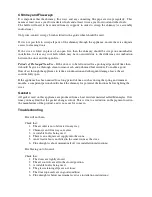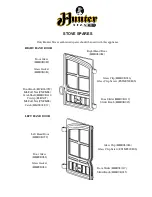
Recommended Solid Mineral Fuels
Only authorised fuels may be used in UK smoke control areas. A list of authorised fuels can be
found at
http://uksmokecontrolareas.co.uk/fuels.php
This stove has been independently tested and approved to burn manufactured and natural smokeless
fuels that appear in the HETAS guide. A current list of approved fuels can be found at
http://hetas.co.uk/public/hetas_guide.html
Approval does not cover the use of other fuels either alone or mixed with the suitable fuels listed
above, nor does it cover instructions for the use of other fuels.
Warning!-
Petroleum coke fuels or household waste must not be burnt on this appliance.
Should any difficulties arise over fuel quality or suitability, consult your local approved coal
merchant or:
HETAS Ltd.– Telephone 01242 673257 –
www.hetas.co.uk
Solid Fuel Association – Telephone 0800 600 000 –
www.solidfuel.co.uk
Safety notes for your guidance
FIRES CAN BE DANGEROUS
– Always use a fireguard in the presence of children, the elderly
or the infirm. The fireguard should be manufactured in accordance with BS 8423 – Fireguards for
use with solid fuel appliances.
DO NOT OVERFIRE
– it is possible to fire the stove beyond its design capacity, this could
damage the stove, so watch for signs of overfiring – if any part of the stove starts to glow red, the
fire is in an overfire situation and the controls should be adjusted accordingly. Never leave the
stove unattended for long periods without first adjusting the controls to a safe setting – careful air
supply control should be exercised at all times.
FUME EMISSION
WARNING NOTE
Properly installed, operated and maintained, this appliance will not emit fumes into the dwelling.
Occasional fumes from de-ashing and refuelling may occur. However, Persistent fume emission is
potentially dangerous and must not be tolerated.
If fume emission does persist, then the following immediate action should be taken: -
1.
Open doors and windows to ventilate the room and then leave the premises.
2.
Let the fire go out.
3.
Check for flue or chimney blockage and clean if required.
4.
Do not attempt to re-light the fire until the cause of the fume emission has been identified and
corrected. If necessary, seek expert advice.
The most common cause of fume emission is flueway or chimney blockage. For your own safety
these must be kept clean at all times.
Adverse weather
– In a small number of installations, occasional local weather conditions (e.g.
wind from a particular direction) may cause downdraught in the flue and cause the stove to emit
fumes. In these circumstances, the stove should not be used. A professional flue installer will be
able to advise on solutions to this problem (e.g. anti-downdraught cowl).
CO ALARM
Your installer should have fitted a CO alarm in the same room as the appliance. If the alarm sounds
unexpectedly, follow the instructions given under “Warning Note” above.





































